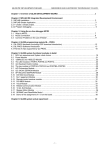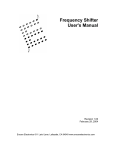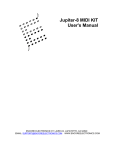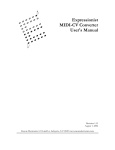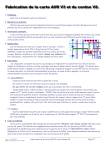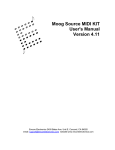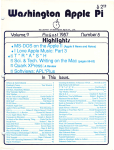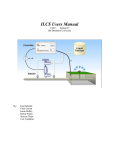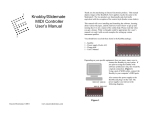Download Universal Event Generator User`s Manual
Transcript
Universal Event Generator User's Manual Revision 2.01 April 13, 2003 Encore Electronics 611 Laird Lane. Lafayette, CA 94549 www.encoreelectronics.com 2 TABLE OF CONTENTS INTRODUCTION ......................................................................................................4 UNPACKING AND INSTALLATION ........................................................................5 FRONT PANEL ........................................................................................................6 MAIN MODE SWITCH..............................................................................................8 GATED OPTIONS SWITCH .....................................................................................9 LOOP SWITCHES..................................................................................................10 SLOPE SWITCH.....................................................................................................11 TROUBLESHOOTING ...........................................................................................12 SPECIFICATIONS..................................................................................................13 3 Introduction Thank you for purchasing the Universal Event Generator ®! The Universal Event Generator (UEG) is an MOTM compatible module that can be used for generating various events in an analog modular system. The UEG has three major modes of operation. The first mode is an eight-stage envelope generator. Compared to a more conventional ADSR, an eight-stage envelope generator can provide a more complicated control signal. Even with this module being microprocessor based, we didn't sacrifice attack speed. The response time is defined as the time it takes the microprocessor to recognize the gate and output its fastest attack signal. The UEG's actual rise time is under 500 microseconds, while its overall response time is under one millisecond. The second mode is a low-frequency oscillator. In this mode, the UEG does not require a gate signal. It will simply cycle between programmable start and end points. Depending on your settings, the UEG can run as fast as 60 Hz, or as slow as one cycle every 50 seconds. With programmable start and end points and adjustable levels, the UEG can go far beyond your simple square wave/triangle wave/ramp wave LFO. The third mode is a simple step sequencer. The UEG will advance one stage for every gate input. Seven of the levels are adjustable using the LEVEL controls, while the eighth level is also adjustable using the TIME8 control. These modes will be covered in greater detail in the following pages. Here are some of the features of the Universal Event Generator: • • • • • • • • • • • • • Three modules in one: envelope generator, LFO, sequencer Eight stages Time and level controls per stage < 1 millisecond rise time Variable loop points Over 8 seconds per stage Three output wave shapes Time control voltage modulation input 0 to 5 V output One LED per stage LEDs are pulse width modulated – Programmable PWM On/Off Manual Gate button Trigger output 4 Unpacking and Installation We’re sure you’re aware, but of course we have to remind you to avoid generating static when handling the UEG (or any electronic circuit). The UEG is packed in an antistatic bag, and should only be opened in a static safe environment. Since this is next to impossible to achieve without special equipment, we will try to give you some practical tips on minimizing static damage to the UEG and your other equipment. The first thing you will want to do is unpack the UEG and install it in your MOTM system. In the antistatic bag you will find the UEG, a power cable, and four screws. Open the bag near your system, and try to install it immediately using the provided screws. While the UEG is out of the antistatic bag, try not to walk around or slide around in your chair. These actions could generate thousands of volts of static electricity and damage the UEG. Depending on the physical access you have to your system, you may want to plug in the power cable before installing the UEG. In the upper left hand corner of the photo below, you should be able to see the word “Power.” Connect the power cable so the wires are oriented where the word “Power” is located. The included cable is wired the same as the official MOTM cables, and can plug in directly to the MOTM distribution board. 5 Front Panel The UEG front panel has more controls per square inch than you are probably accustomed to seeing in an MOTM system. One of our goals was to maintain a consistent look with MOTM modules. We use the same high-quality jacks, the same style knobs and the same style switches. We do use a different style of construction however. Traditional MOTM modules have their PCBs mounted at a right angle to the front panel. The UEG has its PCB mounted parallel to the front panel. This was done in order to minimize the wiring of the 15 potentiometers and six switches. The UEG has eight stages. There is a time control and a level control per stage. The one exception is stage 8: it does not have a level control because stage 8 always returns to zero. The position of the time control determines how much time the UEG will spend in a given stage. Stages 2 through 8 have a time range from 8 milliseconds to 8.3 seconds. Stage 1 has the ability to rise even faster. Its maximum speed is < 1 millisecond! This is on par with the best analog envelope generators. There is a corresponding level control for each stage. Each level control determines the final output voltage when a given stage reaches completion. For example, if a level control is fully clockwise, that stage will output the maximum voltage before moving to the next stage. If a level control is pointing straight up, the output will be one half of the maximum voltage upon completion of that stage. A graphic object has been added to the lower right hand corner of the front panel to help remind you of the capability of these 15 potentiometers. Just below the last level control is the manual gate pushbutton. It is used to trigger the UEG manually. Normally the UEG is triggered by the gate input, but the manual gate pushbutton comes in handy when you're trying to set up the UEG. 6 On the right hand side of the UEG you'll find five toggle switches. These switches change major operating parameters of the UEG and each one has its own section in this manual. At the bottom of the UEG are 4 quarter-inch jacks. The two on the left are inputs and the two on the right are outputs. The GATE input is the signal that initiates a UEG event. The gate input requires a fairly fast ramp such as a square wave or pulse wave. Any MOTM pulse output will work great, as well as a gate or trigger from a MIDI to CV converter such as the Encore Expressionist. The TCV input is used to modulate all the time values. The TCV range is from zero to five volts. When the input is zero volts, it has no effect on the time values. As the TCV input increases from zero, it lengthens the time of each of the stages up to the maximum of 8.3 seconds. If any of the time controls are already at maximum (fully clockwise) the TCV will have no further effect on that stage. The OUT jack is the main control output. Its range is from zero to five volts, and will vary as depicted by the time and level controls. It is a low impedance output and should be able to drive many MOTM inputs. The TRIG OUT jack will emit a short positive pulse at the end of stage 8. The pulse width is 5 milliseconds. It is useful for triggering other modules such as an MOTM 800 envelope generator or another UEG! Its range is also from zero to five volts. Between each of the time and level pots you will find an LED. As the UEG progresses through each of its stages, the corresponding LED will glow. The LEDs are pulse width modulated and will offer some visual feedback relating to the output voltage. This feature is more noticeable when the time values are set long. Experiment with the module and you will quickly realize how the brightness of each LED relates to the output voltage as it's rising and falling through all of the stages. One particular point may be worth pointing out: remember we told you stage one is faster than the other seven stages? If stage one is set near fully counterclockwise, the LED will appear dimmer than the rest. This is because the UEG spends very little time in stage one and doesn't have much time to light the LED. 7 Main Mode Switch The switch highlighted in the upper right corner controls the main operating modes of the UEG. LOOP ONLY: In the top position, the UEG will loop between the START and END loop points indefinitely without a gate signal. This behavior is like a low-frequency oscillator. In this mode the UEG can run as fast as 60 hertz or as slow as one cycle every 50 seconds. To generate a simple triangle wave LFO move the START loop switch to position four, the END loop switch to position five, and set the levels for stages four and five to opposite ends. If the time controls for levels four and five are equal (and the slope is set to linear) you'll get a perfect triangle wave. ONE SHOT: In the center position, the UEG behaves as a fairly straightforward eight-stage envelope generator. Any clean gate*, regardless of pulse width, will trigger the UEG and it will progress through all eight stages. In this mode you could think of the gate signal as a trigger input. GATED: The bottom position is similar to the one shot mode, but is a lot more complicated. In fact the gated mode has a second switch to control multiple functions. The front panel shows a line between these two switches. The main difference between gated mode and one shot mode is that the UEG will continue to generate an event while the gate is present. This will be discussed in detail on the next page In any of these modes the TCV input will have an effect with the exception of GATEDSTEP. This mode will also be covered on the next page. * A clean gate is a signal that has a relatively fast rise time and fall time. Two examples would be a square wave or a pulse wave. A sine wave, triangle wave, or ramp wave are not good candidates for generating a clean gate. 8 Gated Options Switch The gated options switch defines the various submodes of the UEG when it is in gated mode. STEP: in the top position, the UEG can be used as an eight-stage step sequencer. Every rising edge on the GATE input will advance the UEG one stage. The LEVEL controls are used to set the output voltage for each of the seven stages, while the eighth stage is set by TIME8. (This is the only control that isn’t readily apparent from the from panel) When the UEG is at stage eight, the next pulse on the GATE input will advance the UEG to stage one. Also in this mode, the TCV input and the SLOPE switch have no function. FINISH LOOP: in the center position, the UEG behaves similarly as one shot mode with one interesting twist: while the GATE input is maintained, the UEG will continue to loop between the START and END loop points. When the GATE input is removed, the UEG will proceed through all of its stages and end after completing stage eight. Think of this mode as an ADSR with a complex sustained section. RELEASE: in the bottom position, the UEG behaves almost exactly as it does in finish loop mode with one slight difference. When the gate is released in this mode, the UEG will complete the current stage of the loop and then jump to stage eight to end the envelope. Let's say the loop was from stages two to seven and all of the time values were set to maximum. If the gate is released during stage 3, the UEG will complete stage 3 and instead of proceeding to stage four it will proceed to stage eight. New Feature in 2.0: This switch is now active in LOOP ONLY mode. The TRIG OUT jack will now output a trigger at every step of the loop if the STEP switch is set to STEP. The TRIG OUT jack will product a trigger at the end/beginning of the loop if the STEP switch is set to FINISH LOOP. 9 Loop Switches The loop switches simply determine the start and end of the loop. The switches are active only in modes that use the loop which are: GATED-FINISH LOOP, GATED-RELEASE, and LOOP ONLY modes. The LOOP START switch determines the starting point of the loop and can be set from stages two through four. The LOOP END switch determines the ending point of the loop and can be set from stages five to seven. 10 Slope Switch The slope switch determines the shape of the output waveform in all modes except for when the UEG is being used as a step sequencer. The top position is the logarithmic mode. It is an approximation of the output of a true analog envelope generator, which is based on an RC time constant. In the UEG, a microprocessor is computing an approximation using a piecewise linear method. The center position is the linear mode. In this mode the output waveform is a series of straight-line segments. The shape is more typical of digital envelope generators. This is also the shape used in the diagram on the front panel. The bottom position is the step mode. In this mode, the TIME control effects the duration that a level is sustained, rather than the transition time between levels. Using stage one as an example, the UEG jumps to LEVEL 1 and then stays there for the length of time determined by TIME 1. 11 Troubleshooting Issue: Why is the GATE sometimes erratic? The GATE requires a fairly fast rise time in order to trigger properly. If you use a sine wave or a triangle wave, you'll probably experience multiple triggers on both sides of the ramp. Any synthesizer module output labeled pulse or square is a good candidate to trigger the UEG. Issue: Why does the MANUAL GATE pushbutton sometimes trigger multiple times? The MANUAL GATE pushbutton is not debounced. There were a few design decisions that led to this issue. Internally, this button is simply connected to the opamp that receives the GATE input signal. Some switches can generate over 20 milliseconds of bounce. If we were to debounce this switch, it would also delay the input GATE by 20 milliseconds or more. This delay was unacceptable. Another option would have been to add more circuitry to isolate and debounce just the switch, but we didn't have the room. Since our intention for the MANUAL GATE was for setting up the module, we felt this behavior was acceptable under these conditions. Issue: Why is it when I use the TCV input, the relative time values seem to change at some point? The TCV input is used to change the time values of all eight stages. It will make each of the stages’ time longer as the TCV input goes more positive. If any stage reaches its maximum time of 8.3 seconds, it basically runs out of headroom while the other stages still have opportunity to get longer. This condition will cause an imbalance in the relative times of the stages. Issue: Why do some LEDs seem dimmer than others? The LEDs are pulse with modulated and their brightness represents the relative output voltage of the module. If a stage is set to minimum and its previous stage was set to minimum, the LED will have minimum brightness. If a stage is set to maximum and its previous stage was set to minimum, then the LED will start dim and grow brighter. If stage one time is set near fully counterclockwise, it will be especially dim because of the minimum time spent in stage one. 12 SPECIFICATIONS Microprocessor: Atmel: AT90S8535 8-bit RISC Internal clock: 8 MHz D/A converter: 10 bit TLC5615 Output impedance: < 25 ohms Input impedance: >13k ohms GATE trigger voltage: +2.5 V Safe Input range: +/-15V TRIG OUT pulse width: 5 milliseconds Controls TIME (1 through 8): Adjusts time for the respective stage. Range is from one millisecond to 8.33 seconds LEVEL (1 through 8): Adjusts level for the respective stage. Range is from 0 to 5 V. MANUAL GATE: Triggers the UEG manually. General Power requirement: +15V @ 60mA -15V @ 8mA Size: 2U x 5U Depth behind panel: 1.5 inches 13













